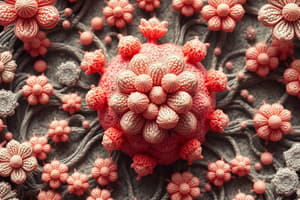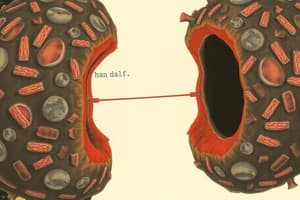Podcast
Questions and Answers
Which cellular adaptation involves a decrease in cell size due to changes in metabolic requirements or environment?
Which cellular adaptation involves a decrease in cell size due to changes in metabolic requirements or environment?
- Hyperplasia
- Atrophy (correct)
- Metaplasia
- Hypertrophy
What is the term for an increase in the size of individual cells, leading to an enlargement of the affected tissue or organ?
What is the term for an increase in the size of individual cells, leading to an enlargement of the affected tissue or organ?
- Dysplasia
- Hyperplasia
- Atrophy
- Hypertrophy (correct)
In the context of cellular changes, which term describes a dynamic steady state where the body maintains a relatively constant composition?
In the context of cellular changes, which term describes a dynamic steady state where the body maintains a relatively constant composition?
- Homeostasis (correct)
- Maladaptation
- Adaptation
- Neoplasia
When cells encounter stress or injury, they may undergo a variety of changes. Which of these is NOT identified as a possible outcome of cellular stress, according to this text?
When cells encounter stress or injury, they may undergo a variety of changes. Which of these is NOT identified as a possible outcome of cellular stress, according to this text?
Which of the following is considered a consequence of overwhelming cellular insult in the context of this discussion?
Which of the following is considered a consequence of overwhelming cellular insult in the context of this discussion?
Considering the information given, if a cell experiences a shift in its environment that causes a reduction in the size of the cell, which process would best describe this?
Considering the information given, if a cell experiences a shift in its environment that causes a reduction in the size of the cell, which process would best describe this?
In the context of cellular adaptations, which adaptation involves an increase in the number of cells?
In the context of cellular adaptations, which adaptation involves an increase in the number of cells?
Which of the following factors is most strongly associated with increased risk of developing malignant melanoma?
Which of the following factors is most strongly associated with increased risk of developing malignant melanoma?
A patient presents with a skin lesion. Which factor would most strongly suggest the lesion could be a basal cell carcinoma rather than a malignant melanoma?
A patient presents with a skin lesion. Which factor would most strongly suggest the lesion could be a basal cell carcinoma rather than a malignant melanoma?
Which of the following risk factors increases the likelihood of both basal cell carcinoma and malignant melanoma?
Which of the following risk factors increases the likelihood of both basal cell carcinoma and malignant melanoma?
A patient's medical history shows multiple instances of radiation therapy. Which skin cancer is MOST directly related as a risk factor?
A patient's medical history shows multiple instances of radiation therapy. Which skin cancer is MOST directly related as a risk factor?
Which factor would be more indicative of melanoma than basal cell carcinoma, in a patient with no known family history?
Which factor would be more indicative of melanoma than basal cell carcinoma, in a patient with no known family history?
When assessing a patient with a noted neck mass, which of the following should be prioritized?
When assessing a patient with a noted neck mass, which of the following should be prioritized?
Which of these is NOT a primary function of the skin as an organ?
Which of these is NOT a primary function of the skin as an organ?
Which of the following is not an element of the ABCDE skin evaluation?
Which of the following is not an element of the ABCDE skin evaluation?
Which of these terms describes a yellowish discoloration of tissues?
Which of these terms describes a yellowish discoloration of tissues?
Which of the following is the most reliable diagnostic tool for meningitis?
Which of the following is the most reliable diagnostic tool for meningitis?
What physiological effect is associated with the toxins of Clostridium difficile?
What physiological effect is associated with the toxins of Clostridium difficile?
A patient presents with a bluish discoloration of the skin. Which term best describes this finding?
A patient presents with a bluish discoloration of the skin. Which term best describes this finding?
Which term is most closely associated with redness of the skin?
Which term is most closely associated with redness of the skin?
What is the significance of nuchal rigidity as a sign of meningitis?
What is the significance of nuchal rigidity as a sign of meningitis?
Which of the following clinical signs are most specifically associated with meningitis?
Which of the following clinical signs are most specifically associated with meningitis?
Besides protection, what is another main function of the integumentary system?
Besides protection, what is another main function of the integumentary system?
Which of the following is a condition, where there is severe itching of the skin?
Which of the following is a condition, where there is severe itching of the skin?
Why is an alcohol-based sanitizer not effective against Clostridium difficile?
Why is an alcohol-based sanitizer not effective against Clostridium difficile?
Which factor is most likely to predispose a patient to Clostridium difficile infection?
Which factor is most likely to predispose a patient to Clostridium difficile infection?
A patient reports a new and very irregular mole. What is the most important next step?
A patient reports a new and very irregular mole. What is the most important next step?
What does the 'B' in the ABCDE skin evaluation stand for?
What does the 'B' in the ABCDE skin evaluation stand for?
A patient diagnosed with a viral infection is experiencing a high fever and muscle aches. Which of the following treatments is the MOST appropriate initial course of action?
A patient diagnosed with a viral infection is experiencing a high fever and muscle aches. Which of the following treatments is the MOST appropriate initial course of action?
What signs and symptoms MOST indicate a C.difficile infection?
What signs and symptoms MOST indicate a C.difficile infection?
Which of the following statements correctly differentiates bacterial from viral meningitis?
Which of the following statements correctly differentiates bacterial from viral meningitis?
Which of the following is NOT a common symptom associated with the reactivation of Herpes Simplex Virus (HSV)?
Which of the following is NOT a common symptom associated with the reactivation of Herpes Simplex Virus (HSV)?
What is the primary mechanism by which Plasmodium parasites cause illness in malaria?
What is the primary mechanism by which Plasmodium parasites cause illness in malaria?
A patient with a weakened immune system develops a widespread disseminated fungal infection. According to the information, which fungal pathogen is most likely responsible?
A patient with a weakened immune system develops a widespread disseminated fungal infection. According to the information, which fungal pathogen is most likely responsible?
Which of these conditions is LEAST likely to be associated with an overgrowth of Candida albicans?
Which of these conditions is LEAST likely to be associated with an overgrowth of Candida albicans?
Which of the following is NOT identified as a risk factor for Candida albicans overgrowth?
Which of the following is NOT identified as a risk factor for Candida albicans overgrowth?
According to the document, which medication is used to lessen the severity of HSV reactivation?
According to the document, which medication is used to lessen the severity of HSV reactivation?
What is the primary mode of transmission of malaria as described in the text?
What is the primary mode of transmission of malaria as described in the text?
In which of the following ways do the fungal infection and the parasitic infection, Malaria differ, based on the content?
In which of the following ways do the fungal infection and the parasitic infection, Malaria differ, based on the content?
Which of the following best describes the nature of fungal organisms as mentioned in the text?
Which of the following best describes the nature of fungal organisms as mentioned in the text?
Based on the information provided, when is the immunization for HSV recommended?
Based on the information provided, when is the immunization for HSV recommended?
Flashcards
Homeostasis
Homeostasis
A state of balance and stability within the body, where internal conditions are maintained within a narrow range despite external changes.
Cellular Adaptation
Cellular Adaptation
Changes that occur in cells to adapt to stress or injury, allowing them to maintain function despite these challenges.
Atrophy
Atrophy
A decrease in the size of a cell, usually happening due to a decrease in metabolic needs or environmental changes.
Hypertrophy
Hypertrophy
Signup and view all the flashcards
Hyperplasia
Hyperplasia
Signup and view all the flashcards
Metaplasia
Metaplasia
Signup and view all the flashcards
Dysplasia
Dysplasia
Signup and view all the flashcards
Jaundice
Jaundice
Signup and view all the flashcards
Cyanosis
Cyanosis
Signup and view all the flashcards
Erythema
Erythema
Signup and view all the flashcards
Pruritus
Pruritus
Signup and view all the flashcards
Pruritus
Pruritus
Signup and view all the flashcards
Meningitis
Meningitis
Signup and view all the flashcards
Bacterial Meningitis
Bacterial Meningitis
Signup and view all the flashcards
Lumbar Puncture (LP)
Lumbar Puncture (LP)
Signup and view all the flashcards
C. difficile Infection
C. difficile Infection
Signup and view all the flashcards
C. difficile Pathogenesis
C. difficile Pathogenesis
Signup and view all the flashcards
Symptoms of C. difficile
Symptoms of C. difficile
Signup and view all the flashcards
Antibiotics and C. difficile
Antibiotics and C. difficile
Signup and view all the flashcards
Treatment of C. difficile
Treatment of C. difficile
Signup and view all the flashcards
Viral Infections Treatment
Viral Infections Treatment
Signup and view all the flashcards
Basal Cell Carcinoma
Basal Cell Carcinoma
Signup and view all the flashcards
Malignant
Malignant
Signup and view all the flashcards
Melanoma
Melanoma
Signup and view all the flashcards
Risk Factors
Risk Factors
Signup and view all the flashcards
Factors for Skin Cancers
Factors for Skin Cancers
Signup and view all the flashcards
HSV Reactivation
HSV Reactivation
Signup and view all the flashcards
Acyclovir
Acyclovir
Signup and view all the flashcards
Candidiasis
Candidiasis
Signup and view all the flashcards
Oral Thrush
Oral Thrush
Signup and view all the flashcards
Nystatin
Nystatin
Signup and view all the flashcards
Malaria
Malaria
Signup and view all the flashcards
Plasmodium
Plasmodium
Signup and view all the flashcards
Anopheles Mosquito
Anopheles Mosquito
Signup and view all the flashcards
Plasmodium Infection
Plasmodium Infection
Signup and view all the flashcards
Candidiasis Sepsis
Candidiasis Sepsis
Signup and view all the flashcards
Study Notes
Homeostasis
- Homeostasis is a dynamic steady state where the body maintains a relatively constant internal composition.
- A functioning cell maintains homeostasis.
- Cells respond to challenges, stress, and injuries by adapting with compensatory changes, developing maladaptive changes, or reversing damage.
- If the insult is too great, cell injury or death can occur.
- Cell responses to stressors depend on the environment and cell type, for instance, brain cells differently than skeletal muscle.
Cellular Adaptations
- Atrophy: Decrease in cell size due to disuse, diminished workload, lack of nerve/hormonal stimulation, or inadequate nutrition. Can be seen with decreased blood flow/ischemia and aging.
- Hypertrophy: Increase in individual cell size, resulting in an enlargement of tissue mass. Often a response to increased workload (e.g., heart hypertrophy in hypertension).
- Hyperplasia: Increase in the number of cells, often driven by hormones (e.g., pregnancy). Leads to increased tissue or organ mass.
- Metaplasia: Replacement of one cell type with another due to environmental changes or chronic inflammation. (e.g., GERD)
- Dysplasia: Deranged cellular growth, often precancerous. Frequently associated with chronic inflammation.
- Neoplasia: Uncontrolled growth; can be benign (non-cancerous) or malignant (cancerous).
Cell Injury/Damage
- Hypoxic cell injury: Oxygen deprivation (anemia, blood flow/circulation issues causing ischemia/lack of oxygen)
- Free radicals/oxidative stress: Unstable molecules damaging cellular components.
- Physical agents: Trauma, temperature extremes, or mechanical stress (e.g., high blood pressure impacting arterial walls)
- Chemical agents: High glucose, poisons, or toxic substances.
- Infectious agents: Viruses, bacteria.
- Injurious immunological reactions: Allergies, autoimmunity.
- Genetic defects: Mutated DNA resulting in dysfunctional/abnormal proteins.
- Nutritional imbalances: Deficiency/excess of specific compounds.
Apoptosis
- Programmed cell death; triggered by cellular damage or genetic programming (e.g., hormonal changes during menopause).
- Apoptotic bodies are phagocytosed without inflammation.
- Failure to undergo apoptosis can lead to cancers and detrimental cell changes in some cases.
Inflammation
- Inflammation is a protective body response to injury.
- Cardinal Signs of Inflammation: Redness (rubor), swelling (tumor), heat (calor), pain (dolor), loss of function.
- Stages of Acute Inflammation:
- Vascular permeability: Blood vessels widen at the site of injury, increasing permeability. Fluids, white blood cells, and platelets travel to the site.
- Cellular chemotaxis: Chemical signals attract white blood cells to the injured area.
- Systemic responses: Body-wide effects such as fever.
Immune System Assessment
- Complete Blood Count (CBC) is used to determine the number of leukocytes (white blood cells) in the bloodstream.
- Increased number of WBCs indicates potential inflammation or infection.
- Normal WBC count: 4,000⁻10,000 cells/mL.
- Leukopenia (<4,000 cells/mL)-Low WBC/Immunity
- Leukocytosis (>10,000 cells/mL)- High WBC/inflammation
- Leukemoid reaction (>50,000 cells/mL)-Extreme Inflammation or infection, potentially cancer
Wound Healing
- Four major phases: hemostasis (stopping bleeding), inflammation (rebuilding), proliferation/granulation (tissue formation), and remodeling (contraction and maturation of the scar).
Factors Affecting Wound Healing
- Poor nutrition, hypoxia (lack of oxygen), impaired blood circulation, compromised immune strength, contamination or infection, obesity, and age are all factors that can affect wound healing.
Infectious Diseases
- Normal flora remain in specific areas, but can cause infection if they invade other areas.
- Opportunistic/Nosocomial infections take advantage of weakened immune systems.
- Nosocomial infections are often hospital-acquired.
- Infectious diseases have unique stages of infection (incubation, prodromal, acute, convalescent, resolution).
- Common bacterial infections (Staphylococcus, Streptococcus, and others) and Viral infections (Influenza, EBV) cause variety of symptoms.
- Parasitic infections (e.g., malaria) are also important considerations.
Immunity
- Immunity involves a complex interplay between innate and adaptive immune systems.
- Innate: nonspecific, immediate, and acts as the first line of defense.
- Adaptive: specific and targeted at particular pathogens with memory for future exposure.
- HIV targets the cells of the immune system, weakening the immune response.
Clinical Manifestations/Treatments
- Clinical manifestations vary among different diseases, and specific infectious diseases have characteristic features.
- Treatment is often symptom-based and may include antibiotics, antivirals, or supportive care.
Practice Question Answers
- The highest risk for HIV transmission usually occurs in specific sexual situations.
- The initial few months immediately after infection are the riskiest for spreading HIV.
- Infected but medicated mothers still carry the potential to transmit HIV to their offspring but have lower rates.
- Needle-stick injury is a dangerous method of HIV transmission.
- Immunity can fail due to CD4⁺T cell destruction from HIV.
Studying That Suits You
Use AI to generate personalized quizzes and flashcards to suit your learning preferences.
Related Documents
Description
Test your understanding of cellular adaptations such as hypertrophy, atrophy, and hyperplasia. This quiz includes questions about cellular stress responses and the dynamic state of cellular composition. Challenge yourself and improve your knowledge on how cells react to their environment.




